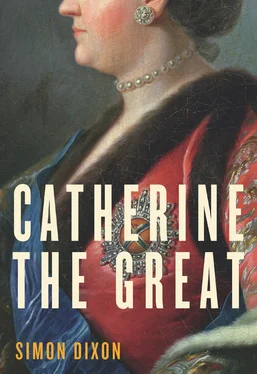Though the infirmities of old age had done nothing to dull her mind—in addition to her memoirs, she was still at work on a history of Russia in the last years of her life—they made it harder for Catherine to cope with the stresses of Court ceremonial. The arrival in August 1796 of a 140-strong Swedish delegation was bound to take its toll. Led by the duke of Sudermania, the brother of the late Gustav III, the Swedes had come to secure the betrothal of the empress’s eldest granddaughter, Alexandra, to the uncrowned Gustav IV. All the magnificence of the Russian Court was laid out to impress the young king, but on 11 September, when the ceremony was due to take place, he refused to appear, objecting to Catherine’s insistence on a written guarantee that Alexandra would be allowed to practise the Orthodox faith in Lutheran Sweden. Whether or not the empress suffered the mild seizure rumoured by one contemporary, she was irritated and exhausted by such a public failure. 102Although she summoned the energy to celebrate the thirty-fourth anniversary of her coronation at a ball in the St George’s Hall of the Winter Palace, the throne room completed by Quarenghi in 1792, public appearances were now infrequent. At lunch in the Diamond Room on Friday 31 October, Arkady Morkov, the negotiator who had struggled in vain to satisfy the Swedes, sat beside companions of much longer standing. Catherine had known Ivan Shuvalov even before he became Elizabeth’s favourite in 1749; the Marshal of her Court, Prince Fëdor Baryatinsky, had guarded her husband at Ropsha on the fateful night in 1762 when Peter III was assassinated; soon afterwards, the faithful Anna Protasova had joined the Court ladies at the behest of Aleksey Orlov (according to Countess Golovina, she was nicknamed ‘la reine’, because she was as dusky as the queen of Tahiti). Later that evening, these intimates were joined at the Hermitage by the empress’s grandsons and granddaughters, as the empress watched a French comedy incognito in the presence of her Court and the whole generalitet . 103
That, it transpired, was the last entry in the Court journals for Catherine’s reign. The end, when it came, took everyone by surprise. On the morning of Wednesday 5 November, she settled down to her papers after her customary morning coffee. But when the duty chamberlain arrived sometime after nine, he found her palpitating body, barely conscious, on the floor of the neighbouring dressing room. Despite his efforts to revive her, she lapsed into a coma from which she never recovered. Six men were required to lift her into the bedroom, where Dr Rogerson, having diagnosed a stroke, tried in vain to bring her round. Soon Catherine’s confessor was summoned; Metropolitan Gavriil arrived that afternoon. Tended by Protasova and Maria Perekusikhina, their sovereign was vomiting so much blood that it was only when the flow briefly abated that she could be given communion and anointed with holy oil. Count Nikolay Zubov was sent to Gatchina to fetch Grand Duke Paul, who had dreamed the night before of being visited by a mysterious, unknown force. Though he rushed to take charge at the Winter Palace, there was little he could do. Informed at dawn next morning that all hope was lost, he ordered that Catherine be given the last rites. Now he could only watch and wait as his mother’s pulse gradually faded. Not until a quarter to ten on the evening of 6 November 1796 did the most famous woman in Europe finally breathe her last. 104
EPILOGUE
The Afterlife of an Empress
After thirty-four years on the throne, Catherine had become synonymous with Russian rule. Most of her subjects could remember no other monarch. Finding it impossible to imagine anyone else in her place, the Court was stunned by her unexpected demise. ‘No one knew what to do,’ admitted Platon Zubov’s dwarf amanuensis, Ivan Yakubovsky: ‘The mind could not grasp that this time had come.’ 1It did not take them long to realise, however, that in an intensely personal monarchy such as the Russian empire, the accession of a new ruler could immediately signal a radical reversal of regime. By the time that shocked courtiers arrived at the Winter Palace on the morning after Catherine’s death, ‘the change was so great that it looked like nothing other than an enemy invasion’. 2All the empress’s ‘brilliance’ seemed to have vanished into thin air as her successor staged the first of the military parades that were to dominate life at his Court. Not for nothing did the poet Derzhavin refer to Tsar Paul’s accession as an act of conquest: armed soldiers were everywhere. ‘The ease and tranquillity of the late Reign are lost with Her from whom they deriv’d,’ the British ambassador reported barely a fortnight after Catherine’s death. ‘A most severe and exact discipline is introduced into every department both civil and military, and this with such a degree of rigour, as has even absolutely chang’d the face of society.’ 3
The Russian succession in 1796 was in practice no more controversial than it had been in December 1761 on the death of Elizabeth. In accordance with Peter the Great’s succession law of 1722, Catherine had nominated her Russian-born son as her heir immediately after her coup. Although her growing dissatisfaction with Paul prompted her to investigate the history of the regulations governing the succession when she returned from the Crimea in 1787, and rumours circulated after 1791 that she intended to disinherit him in favour of her grandson Alexander, it seems unlikely that she would ever have taken such a fateful step. Alexander’s Swiss tutor claimed to have suffered ‘the two most unpleasant hours’ of his life at an audience in 1793, in which the empress, without raising the subject directly, apparently tried to persuade him to broach the idea with his pupil. Paul certainly lived in trepidation that his mother might disinherit him, and some historians believe that he found and destroyed a draft law of succession on the night of 6 November. Yet the circumstances of Catherine’s own accession surely ruled out any open discussion of the subject while she was alive. To issue a law of succession would have been to advertise her status as a usurper. 4
In any case, no prominent actor at the Court of St Petersburg seriously doubted that Paul would inherit the throne. The only uncertainty lay in what he would do once he finally had power within his grasp. It was obvious to all that his natural impatience had been intensified by years of waiting in the wings. While the grand duke remained isolated at Gatchina, endlessly parading his troops, the cream of Russian society had been anxious for some time about what lay in store for them. After Potëmkin’s death threw into question the future of his extensive network of clients, John Parkinson was told in 1792 that Paul’s accession was to be ‘feared’ because he was ‘anxious to make alterations and regulations which would make it more difficult to commit abuses’. The following year, Parkinson was again warned that ‘all may not go well, perhaps’ at the empress’s death. 5No one, however, had fully anticipated the speed and determination with which the new tsar would reject everything his mother had stood for. ‘The most important practices of the Court were changed,’ recalled Countess Varvara Golovina, ‘and with the wave of a baton he destroyed what had taken a glorious reign of thirty-four years to consolidate.’ 6
Appalled by the paltry burial that Catherine had given to Peter III, whom he always regarded as his father, Paul initially intended to consign the empress to an equally anonymous grave in the cemetery at the Alexander Nevsky monastery. There would have been no clearer way of declaring that his mother had no right to rule. Only when he was persuaded that this was politically impossible did he consent to funeral arrangements that followed the pattern established for Russia’s rulers since the death of Peter the Great. 7Catherine’s corpse was embalmed on 8 November and carried on 15 November from her bedroom to the audience chamber of the Winter Palace. It was an emotional scene for the courtiers who had been closest to her. According to Countess Golovina, who recalled the ceremony in openly sentimental terms, the occasion was stage-managed by the new empress, Maria Fëdorovna, whose officious approach to the proceedings ‘cut me to the heart’. The countess herself claimed more in common with the melancholy scene she observed through the door of the Chevaliers Gardes’ Room, which was draped from floor to ceiling in swathes of black silk and lit only by the flickering flames in the hearth. ‘A mournful silence reigned in the apartment, interrupted only by sobs and sighs,’ as the Chevaliers, dressed in their red capes and silver helmets, stood listlessly about, ‘some leaning on their carbines, others lying on chairs’. Only the sound of the approaching funeral chant roused the countess from the ‘depression’ into which this ‘mournful sight’ had plunged her:
Читать дальше












